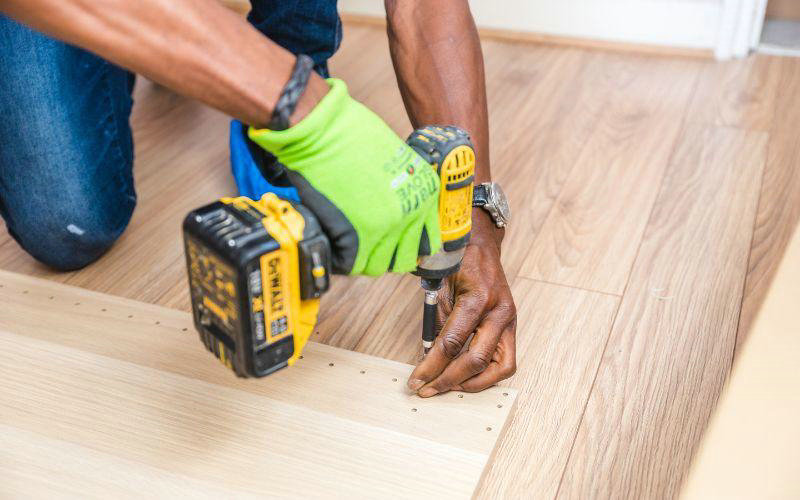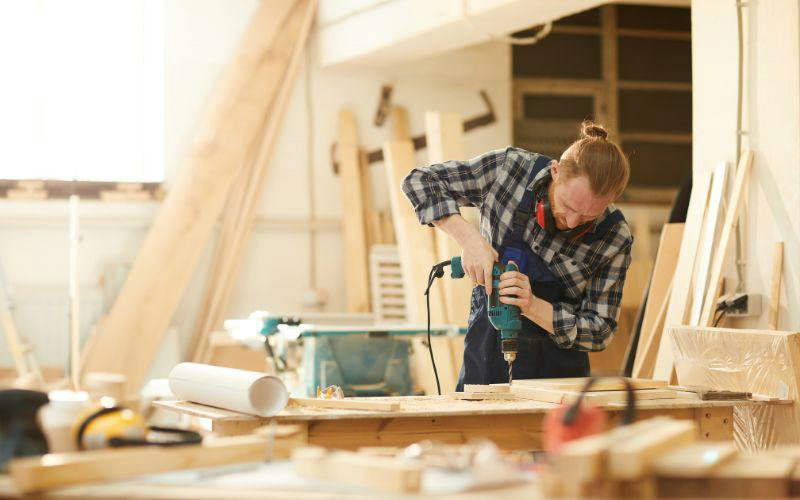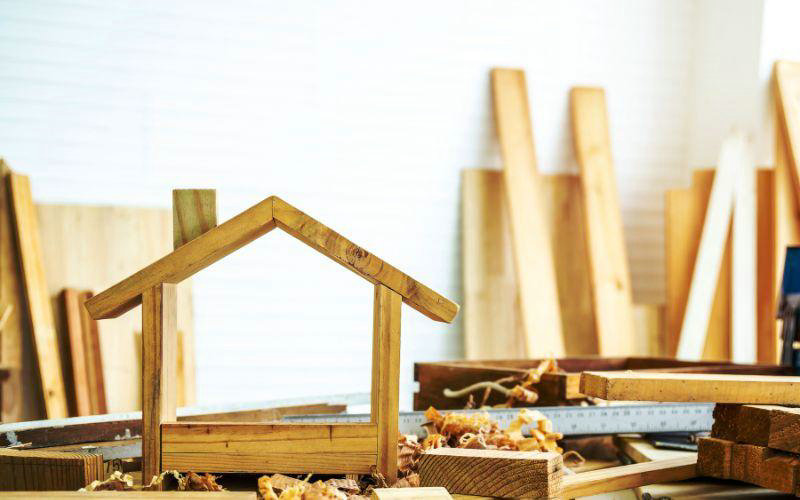
If you wanna start a wood project, you definitely don’t want your wood to get damaged during assembly. A pilot hole is a perfect guide for your work; it can guide you where you should put your screws in without damage. This article will show you why pilot holes are important, how to drill pilot holes, and what size of pilot hole is suitable for your work.
Key Takeaways:
Pilot Hole Sizes for Wood Screws
| Screw Size | Hard Wood | Soft Wood | Countersink Size | ||
|---|---|---|---|---|---|
| Tapered Bit | Straight Bit | Tapered Bit | Straight Bit | ||
| #2 | 3/32″ | 1/16″ | 5/64″ | 1/16″ | 1/4″ |
| #3 | 7/64″ | 5/64″ | 3/32″ | 1/16″ | 1/4″ |
| #4 | 7/64″ | 5/64″ | 3/32″ | 1/16″ | 1/4″ |
| #5 | 1/8″ | 3/32″ | 7/64″ | 5/64″ | 5/16″ |
| #6 | 9/64″ | 7/64″ | 1/8″ | 3/32″ | 5/16″ |
| #7 | 5/32″ | 7/64″ | 9/64″ | 3/32″ | 5/16″ |
| #8 | 11/64″ | 1/8″ | 5/32″ | 7/64″ | 3/8″ |
| #9 | 3/16″ | 9/64″ | 11/64″ | 1/8″ | 3/8″ |
| #10 | 13/64″ | 9/64″ | 3/16″ | 1/8″ | 7/16″ |
| #12 | 7/32″ | 5/32″ | 13/64″ | 9/64″ | 7/16″ |
| #14 | 1/4″ | 11/64″ | 15/64″ | 5/32″ | 1/2″ |
| #16 | 9/32″ | 3/16″ | 17/64″ | 11/64″ | 9/16″ |
| #18 | 5/16″ | 7/32″ | 19/64″ | 13/64″ | 5/8″ |
| #20 | 21/64″ | 15/64″ | 5/16″ | 7/32″ | 3/4″ |
| #24 | 3/8″ | 17/64″ | 3/8″ | 1/4″ | 3/4″ |
Everything You Need To Know About Pilot Holes
The importance of pilot holes in woodworking cannot be overstated. Pilot holes are pre-drilled holes that guide screws into the correct position while protecting your workpiece from damage.
When fastening screws without pilot holes, the wood is forced to compress as the screw enters. This compression causes the wood fibers to split or crack, especially in soft woods. Pilot holes give the fibers room to move aside as the screw passes through.
Pilot holes also prevent stripping of the screw head or thread. Forcing a screw directly into solid wood applies enormous pressure to a very small contact point. This pressure can easily strip screws before they are fully set. A pilot hole relieves this pressure and allows the screw to seat cleanly.
Proper use of pilot holes ensures a strong, accurate screw joint. It’s a small extra step that makes a big difference in the quality and longevity of any woodworking project. Take the time to drill pilot holes matching your screw size and your projects will go together smoothly and beautifully.
Here’s a quick rundown on why they’re crucial:
- Reduces Wood From Splitting: Pilot holes allow the screw threads to cut neatly into the wood, hugely decreasing the risk of the wood cracking, especially near the edges or at the end of the board.
- Increases Accuracy: It’s tough to get a screw to enter the material precisely where you want it without a guide. A pilot hole ensures your screw placement is exactly where you intended.
To drill a pilot hole, you will need a drill bit that matches the size of the screw’s shank (the solid part beneath the screw head and above the threads). This is important: if the pilot hole is too small, you risk splitting the wood when you insert the screw; if it’s too large, the screw won’t have enough material to grip onto. Generally, when you drill hardwood, the pilot holes will be slightly larger than the screw’s shank.
When You Need to Drill Pilot Holes

The most important feature of pilot holes is that they can protect the wood from damage; here are the 3 noticeable situations when you need to drill pilot holes.
- When you want to fasten your screws near the ends or edges of boards: This place is where wood is most prone to splitting. Pilot holes can make your screws go directly into the edges of the wood without adding extra pressure.
- When you fasten screws in hardwoods: These materials are more likely to split than softer woods, so a pilot hole can make a big difference.
- When you need precise Screw Locations: If your project requires screws to be placed at specific spots with little room for error, pilot holes are a must.
Here’s how you decide when it’s essential:
- Assess the Wood Type: Hardwoods almost always require pilot holes, while softer woods may be more forgiving.
- Check Screw Size: Larger screws are more likely to cause splitting and will benefit from a pilot hole.
- Consider Screw Placement: If you’re screwing near an edge, a pilot hole can prevent the wood from cracking.
By following these guidelines, you’ll help ensure a successful, clean finish for your woodworking projects.
Choosing the Right Drill Bit
Selecting the right drill bit is crucial for successfully drilling pilot holes for wood screws. The bit size should match the screw size to prevent wood splitting.
Factors Determining Drill Bit Size
When you’re choosing a drill bit for your work, you need to consider the gauge or diameter of the screw you’re working with. With softwoods, you can use a bit closer in size to the screw’s diameter, because softwoods can compress more around the screw.
Another factor is the type of drill bit. A twist drill bit is commonly used for this task because it offers a good balance between strength and precision. The length of the screw also plays a role; longer screws need deeper pilot holes. Always measure the drill bit against the screw to ensure it doesn’t exceed the screw’s length – otherwise, your screw won’t hold.
Preparing to Drill

Before you get started, it’s important to have all your tools ready and accurately mark where you’re going to drill. This initial step sets the stage for a smooth and precise drilling experience.
Gathering Necessary Tools
To ensure a successful drilling project, first gather the following tools:
- Drill: Choose a drill that is appropriate for the size of the screw and the hardness of the wood.
- Drill bits: Select a bit that is slightly smaller than the screw’s shank for nails or matches the inner diameter of the screw’s threads for wood screws.
- Tape measure or ruler: For precise measurements.
- Calipers (optional): For cases where exact measurement of the screw and drill bit is needed.
- Pencil: To mark the drilling point.
- Center punch (optional): To create a small indentation and guide the drill bit.
Marking the Drill Point
Marking the drill point accurately is a crucial part of the preparation process:
- Measure: Use your tape measure or ruler to determine the exact spot for the indentation. It’s essential that this measurement is precise, as it dictates where your fastener will go.
- Mark: With a pencil, draw a small, clear mark on the wood where you want to drill. If your project requires the utmost precision, you might use a center punch to make a small indent at the mark, giving your drill bit a place to rest and ensuring it doesn’t wander when you begin drilling.
The Drilling Process
Preparing to drill pilot holes is an essential step in working with wood. It ensures the integrity of your material and the quality of the final construct. Your chosen drilling technique and the pursuit of accuracy will directly impact the end result.
Drilling Techniques for Different Types of Wood
When dealing with hardwood, which is a denser material, you’ll need to apply more force but at a slower speed to avoid overheating the drill bit and damaging the wood fibers. Start with a smaller drill bit and work your way up to the desired hole size in increments to ensure a clean cut.
For softwood, which compresses more easily, you can use a faster speed and less force. Despite the pliability of softwood, be careful not to underestimate the importance of the correct bit size as it still can split under pressure if not drilled correctly.
Ensuring Straight and Accurate Holes
To drill holes that are straight and accurately located:
- Mark the spot where you will be drilling with a pencil. Double-check measurements before proceeding to ensure the hole will be in the right place.
- Use a punch tool or a nail to make a small indentation at the mark. This will prevent the drill bit from wandering when you start to drill.
- Choose the correct drill bit. Using a drill bit that’s too large will result in a loose screw and less grip.
- Align the drill so that it’s perfectly vertical to the wood surface. You can use a drill guide to assist with this if necessary.
- Drill steadily, with moderate pressure, and back out the bit periodically to clear out sawdust and prevent wood burn.
Maintaining your equipment and patience throughout the drilling process will greatly improve the quality of your pilot holes, ensuring a solid hold for your screws and a polished finish on your project.
Post-Drilling Actions
After drilling your pilot holes, it’s essential to follow some critical steps to ensure your woodwork is neat and sturdy. These post-drilling actions will help your screws sit correctly and the joints to hold firm.
Creating a Countersink
Countersinking is a necessary step if you want a smooth finish, with screw heads sitting flush or just below the surface of your wood. Here’s how to proceed:
- Select the right countersink bit for your screw head type. The bit should match the size of the screw head, creating space for it to sit snugly.
- Align the countersink bit with the pilot hole and apply slight pressure with your drill.
- Drill slowly until the countersink hole is deep enough to allow the screw head to sit flush with the wood surface.
Tip: Always stop periodically to check the depth. Over-drilling can weaken the joint.
Finish and Fastening Tips
Fastening your screw properly ensures a strong and long-lasting joint. Here’s what to keep in mind:
- Select a screwdriver or driver bit that fits the screw head. An ill-fitting driver can strip the screw head and make it difficult to fasten securely.
- Use moderate pressure when tightening the screw. Over-tightening can strip the threads or break the screw.
- For optimal force distribution, make sure the shank of the screw passes through both pieces of wood.
- If your piece requires it, a clamp can be used to hold the joint tightly as you fasten the screw, preventing movement that could misalign the holes.
- Confirm there is a clearance hole in the top piece of wood to allow the screw’s body to pass through without thread engagement. This ensures the pieces are pulled tight instead of just pinning them together.
By carefully countersinking and following these fastening tips, you’ll create a clean and secure finish for your woodworking project.
In conclusion, drilling pilot holes is an important step when installing wood screws that ensure a tight, long-lasting fit. As demonstrated, pilot holes prevent wood from cracking or splitting and allow screws to sink deeply into the material without resistance. Following this simple technique can help any woodworking project hold together effectively over time. While it may seem like an extra step, taking the time to drill pilot holes is well worth the effort to achieve strong, accurate screw placements that will withstand regular use and weathering. Homeowners and woodworkers alike will benefit from mastering this best practice for secure screw installation in their projects.
